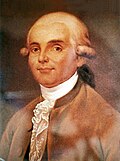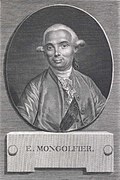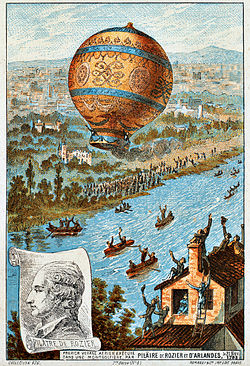AY Honors/Hot Air Balloons/Answer Key
1. State the role each of the following played in the development of flying balloons.
a. Joseph Michel Montgolfier and Jacques-Etienne Montgolfier
Joseph-Michel Montgolfier (26 August 1740 – 26 June 1810) and Jacques-Étienne Montgolfier (6 January 1745 – 2 August 1799) were the inventors of the montgolfière, or airship. The brothers succeeded in launching the first manned ascent, carrying a young physician and an audacious army officer into the sky.
Of the two brothers, it was Joseph who first contemplated building "machines". Joseph observed laundry drying over a fire incidentally form pockets that billowed upwards. Joseph set about building a box-like chamber 1 by 1 by 1.3 meters![]() out of very thin wood and covering the sides and top with lightweight taffeta cloth. Under the bottom of the box he crumpled and lit some paper. The contraption quickly lifted off its stand and collided with the ceiling. Joseph then recruited his brother to balloon building.
out of very thin wood and covering the sides and top with lightweight taffeta cloth. Under the bottom of the box he crumpled and lit some paper. The contraption quickly lifted off its stand and collided with the ceiling. Joseph then recruited his brother to balloon building.
The two brothers then set about building a contraption 3 times larger in scale (27 times larger in volume). The lifting force was so great that they lost control of their craft on its very first test flight on 14 December 1782. The device floated nearly 2 kilometres (about 1.2 mi). It was destroyed after landing by the "indiscretion" of passersby.
b. Jean Francois Pilatre de Rozier and Francois Laurent Marquis d'Arlandes.
Jean-François Pilâtre de Rozier (30 March 1754 – 15 June 1785) was a French chemistry and physics teacher, and one of the first pioneers of aviation. His balloon crashed near Wimereux in the Pas-de-Calais during an attempt to fly across the English Channel, and he and his companion, Pierre Romain, became the first known victims of an air crash.
In June 1783, he witnessed the first balloon flight of the Montgolfier brothers. On 19 September, he assisted with the untethered flight of a sheep, a cockerel and a duck from the front courtyard of the Palace of Versailles. After a variety of tests in October, he made the first manned free flight in history on 21 November 1783, accompanied by the ambitious Marquis d'Arlandes. During the 25-minute flight using a Montgolfier hot air balloon, they traveled 12 kilometres from the Château de la Muette to the Butte-aux-Cailles, then in the outskirts of Paris, attaining an altitude of 3,000 feet.
c. Jacques Alexandre Cesar Charles and Nicolas Louis Robert.
In December of 1783, these two flew the first gas balloon, filled with hydrogen. This flight lasted for at least 2 hours, starting from the Tuileries gardens in Paris, and landing outside Paris where it was destroyed by terrified peasants.
Charles went on to discover Charles' Law which describes the relationship between the density of a gas and its temperature.
d. Ben L. Abruzzo, Maxie L. Anderson, and Larry Newman
From 11 August to 17 August, 1978, these three completed the first transatlantic balloon flight in the Double Eagle II. They began their flight from Presque Isle, Maine and ended their flight at Miserey, France.
Ben Abruzzo and Larry Newman were also pilots on the Double Eagle V which in 1981 was the first balloon to cross the Pacific Ocean.
e. Bertrand Piccard and Brian Jones
On March 1, 1999, Bertrand Piccard and Brian Jones began the first balloon flight to circumnavigate the earth. Their flight was a success and ended on March 20, 1999. The flight took 19 days and 21 hours. The flight started in Switzerland and ended in Egypt.
2. Cite the principle of Archimedes, and briefly describe how it applies to each of the following:
- Archimedes' Principle states: any body fully or partially submerged in a fluid is buoyed up by a force equal to the weight of the fluid displaced.
- a. A piece of cork floating in a bowl of water.
Cork is less dense than water, and weighs less than the volume of water displaced, causing the cork to float.
- b. A ship floating in the ocean
Ships, though made of dense materials, are shaped so that much of the interior is air. Because the weight of the ship and its cargo is less than the volume of water displaced, the ship will float.
- c. A hot air balloon floating in the atmosphere
As long as a balloon plus the gas it contains weighs less than the atmospheric air which it displaces, the balloon will float in the air.
3. Using a textbook of Chemistry, or a reference book of scientific tables, draw up a simple table showing the composition of air by weight and by volume.
| Nitrogen | 78% |
| Oxygen | 21% |
| Argon | .93% |
| Carbon Dioxide | .03% |
| Other (including Neon, Helium, Hydrogen, Xenon, & Radon) |
.04% |
4. Draw up a simple table showing a comparison of the atomic number, atomic weight, and density of hydrogen, helium, nitrogen, and oxygen.
| Atomic Number | Atomic Weight | Density (g/cm³) | |
|---|---|---|---|
| Hydrogen | 1 | 1.008 | 0.00008988 |
| Helium | 2 | 4.003 | 0.0001785 |
| Nitrogen | 7 | 14.01 | 0.0012506 |
| Oxygen | 8 | 16.00 | 0.001429 |
5. Name two gases that are used in flying gas filled balloons.
Hydrogen & Helium are both less dense than air and may be used when flying a balloon. Warm air is also used for flying balloons, since it is less dense than cold air.
- Note: Hydrogen burns violently when ignited. After the destruction of the Hindenburg, hydrogen was largely abandoned for the flying of manned balloons.
6. Explain how heat/temperature affect the density of air, and how this applies to flying hot air balloons.
As described by Charles' Law, heat applied to a gas will cause its molecules to move farther apart, reducing it's density. When the air in a balloon is heated above the temperature of the surrounding air, the air in the balloon becomes less dense than the air outside the balloon. Because the balloon is less dense, it will float or rise. The greater the difference in temperature between the air in the balloon and the surrounding air, the greater the difference in density between the air inside and outside the balloon, which increases the lift that the balloon will generate. This explains why balloons are mostly launched in cooler weather.
7. Explain the role of each of the following in the structure and flying of a hot air balloon.
- a. Envelope
- The outer skin of the balloon, forming the container that holds the gas.
- b. Support structure
- The framework of larger balloons.
- c. Throat
- The lower opening through which the hot flame is applied to heat the air.
- d. Fuel source
- The fuel used to heat the air to make the balloon less dense than the surrounding air.
8. Name two materials that may be used for the envelope of a hot air balloon, and compare the advantages each cords because of its properties.
- Paper
- Paper may be used for model hot air balloons because of ease of acquisition and low price.
- Plastic
- Plastic may be used for model hot air balloons because it is water resistant, easy to work with, and easy to acquire.
- Fabric
- Fabric is usually used for larger, manned balloons. The fabric is specially treated.
9. Describe how flying balloons have served a useful function in
a. Military campaigns
Military uses include: “eyes in the sky”, observation of enemy troops and positions, delivery of explosives to enemy positions, and defensive use of entangling incoming enemy flying craft.
b. Scientific research
Scientific uses include instrument transport for data collecting, atmospheric studies, and aerial photography.
10. At what time of the day do most sport balloon flights take place? Why?
Early morning is best because the air has cooled over night making the difference of temperature inside & outside greater, thus increasing buoyancy.
11. Describe how a pilot controls the vertical movement of
a. A hot air balloon
The pilot controls the vertical movement of a hot air balloon by burning more fuel to make the air in the balloon hotter, causing the less dense air in the balloon to make it rise. Conversely, turning off the flame and allowing the air in the balloon to cool renders the air in the balloon more dense with respect to the surrounding atmosphere, causing the balloon to descend.
b. A gas filled balloon
Adding more of the lighter than air gas to ascend, and spilling some of the gas in order to descend varies the altitude of a helium or hydrogen filled balloon.
12. Describe how a pilot controls the lateral or horizontal movement of a flying balloon.
Horizontal movement of a gas filled flying balloon is entirely at the mercy of air currents. The pilot can only vary the altitude so as to get into the path of air currents, such as the jet stream. This involves careful study of charts of air currents, close attention to weather data, and a certain element of trial and error. Older airships, like the Hindenburg, had a rudder and propellers to move it so that it did not have to depend on air currents.



